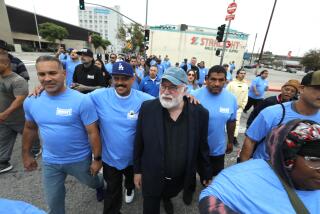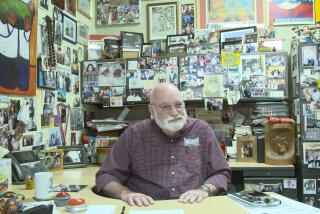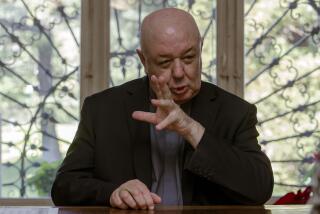WORLD REPORT PROFILE : Rev. Leonard Boyle : ‘GOD’S LIBRARIAN’ IN ROME : A Dominican priest is busy bringing the computer to the Middle Ages. Coming soon: the Vatican library on the Internet.
- Share via
VATICAN CITY — On a bright spring morning at the Vatican, the priest sometimes called God’s librarian works at the cusp of historic change.
Seated at a scarred wooden table, Father Leonard Boyle examines a manuscript in Latin transcribed and lovingly illuminated by a decorative artist in Paris about 700 years ago. Boyle uses the table because a technician has commandeered his desk to fiddle with the computer there.
The transmission of knowledge typified by the men who painstakingly completed the manuscript back then, and by the experts who study it now, is a constant that transcends time and place, Boyle is saying in a rich brogue.
“A library like this one will last forever. I say it bluntly and unequivocally. It’ll last as long as it lasts,” he said.
There is more that the scholar-director of one of the great repositories of human knowledge has to say. But the technician interrupts, well-pleased with his modern feat of intellect. As of this moment, the technician announces, the director of the Apostolic Vatican Library is on the Internet. He rattles off a string of letters and numbers: “That is Father Boyle’s Internet address.”
The ether purrs. So does Father Boyle.
Why not? Here is a student of history who comfortably abides at the challenging if sometimes disconcerting junction where old, printed meets new, electronic.
Wry, sharp-eyed and sharp-tongued, Boyle is a catalyst to the encounter, a 71-year-old Dominican priest and medieval scholar who is revolutionizing the library that he has headed since Pope John Paul II appointed him in 1984, succeeding a cardinal in the job.
Boyle believes in access to information. He is bringing the computer to the Middle Ages and the Vatican library to the world. The library’s catalogue is now accessible through the Internet. And starting this fall, about 20,000 manuscript pages and the stunning miniatures painted on them should be electronically available to scholars around the world as part of a project funded by IBM.
“I think, ‘How the blazes did we do without computers?’ I’m more than comfortable with them. As an information access, they’re invaluable, and at times unbelievable,” Boyle said. But he reveres the ancient source material as well. “Is computer information a substitute for the source from which the information comes? No, no.”
Around him in hushed library halls, about 200 visiting scholars are parsing ancient manuscripts penned in languages no one speaks any more. Many of the researchers have brought laptop computers on which to take notes. They have come from all over the world to touch and savor history under Boyle’s approving gaze.
“There is a qualitative difference between any digitalized copy and hard parchment or paper which has its own watermarks and discolorations as testimony to its own history. A manuscript copy is a living thing, the annotations, the slightly different text. True scholars will never be satisfied with digitalized copies alone,” said the man who protects more manuscripts than anybody.
Tucked behind stout Vatican walls, a library founded under Pope Sixtus IV in 1475 is as distinctive as its director: Its lifeblood is 150,000 manuscripts, most in Latin, some in Greek, all handwritten, most from the Middle Ages but some dating to the first centuries after the death of Christ.
There are about a million books as well, including priceless collections put together across the centuries by Popes and European noble families. But they are not what matters most, in Boyle’s view: “This is a manuscript library which happens to have an appendage of printed books; they are there to provide backup for manuscript researchers.”
The manuscripts, usually between 200 and 400 pages, are often mini-libraries themselves, containing the transcribed wisdom of 10 or 15 different books. It will be long decades before scholars know fully what all the manuscripts contain, but the collection is both catholic and eclectic.
“The myth is that the Vatican library is an ecclesiastical library. It’s run by the church, but it’s a library of the human race: poetry, music, art, history, science, literature, law, medicine, geography, anything,” Boyle said.
Church documents are stored next door in the separately administered Vatican Secret Archives.
Leonard Eugene Boyle, a specialist in medieval manuscripts, first came to the library as a young researcher among the aged documents he now oversees. Born in Donegal, Ireland, on Nov. 13, 1923, he joined the Dominicans when he was 20 and was ordained six years later in 1949. In 1956, he earned his doctorate from Oxford in England.
Boyle taught theology in Rome until 1961, then moved to Toronto, where until 1984 he was professor of paleography and diplomatics, official documents, at the Pontifical Institute of Medieval Studies, becoming a Canadian citizen.
Most summers, though, found him in the Vatican library and archives. He wrote a survey of the archives to aid fellow scholars, a bibliographical introduction to Medieval Latin paleography and a study called “Pastoral Care, Clerical Education and Canon Law, 1200-1400.”
A shade dry? Boyle would as happily talk about soccer, of which he is canny enough a judge that it is smarter not to bet against him.
Or, hear him talk about the splendid basilica of San Clemente in central Rome near the Colosseum, whose foundations date to the 4th Century. Boyle says Mass there Sunday afternoons, delivers a gentle homily in Italian and adjourns to dinner with fellow Irish Dominicans. His friends run San Clemente and cook the dinner; Boyle wrote a book about the church.
He says the computer bug bit about 10 years ago, after he attended a conference in Heidelberg, Germany: “I was only yielding to a little bit of pressure inside and a little bit of outside pressure because people wanted the Vatican library unlocked.”
He unlocked it, ordering computerization of a card catalogue that had been assembled in the 1920s by specialists on loan from the Library of Congress. Now the computer is both a fact of life and a mixed blessing at the Vatican’s 500-year-old treasure trove, in Boyle’s view.
“I have more information now at my disposal than was ever possible when I was a student, and in many ways there’s so much of it you feel you’ve got it all--and you’ve got nothing. The computer can tell you everything about the Bible. But it doesn’t mean that you know the Bible better, or that you even know it at all,” he said.
Boyle picks up the bound manuscript he had been studying before the Internet leaped into his office.
“It’s from the year 1330, and it’s as happy as Larry standing here, in excellent, I won’t say mint, condition, but semi-mint condition. And what do you suppose is the lifetime of a disc? Will we have to renew them like petrol tanks every few years?” he asked.
Boyle hears that in the United States a university campus is being built without any library at all--just hook everything into the net and pull down what’s important. It sounds far-fetched to God’s librarian.
“I wish them luck,” Boyle said. “It’s easy to say we’re dispensing with the printed page. But I don’t think we’re ever going to dispense with the manuscript page for the past, or original records of any type.”
More to Read
Sign up for Essential California
The most important California stories and recommendations in your inbox every morning.
You may occasionally receive promotional content from the Los Angeles Times.










